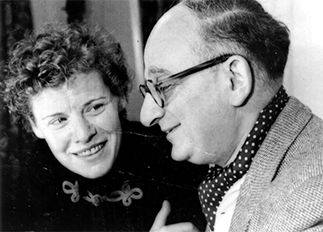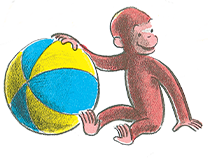Author & Illustrator

H. A. and Margret Rey
Hans Augusto Rey was born on September 16, 1898, in Hamburg, Germany. He grew up there near the world-famous Hagenbeck Zoo, and developed a lifelong love for animals and drawing. Margarete Elisabeth Waldstein (who would be known to most of the world as Margret Rey) was also born in Hamburg on May 16, 1906. The two met briefly when Margret was a young girl, before she left Hamburg to study art. They were reunited in 1935 in Rio de Janeiro, where Hans was selling bathtubs as part of a family business and Margret was escaping the political climate in Germany. Margret convinced Hans to leave the family business, and soon they were working together on a variety of projects.
Hans and Margret were married in Brazil on August 16, 1935, and they moved to Paris after falling in love with the city during their European honeymoon. It was there that Hans published his first children’s book, after a French publisher saw his newspaper cartoons of a giraffe and asked him to expand upon them. Raffy and the Nine Monkeys (Cecily G. and the Nine Monkeys in the British and American editions) was the result, and it marked the debut of a mischievous monkey named Curious George.
After Raffy and the Nine Monkeys was published, the Reys decided that Curious George deserved a book of his own, so they began work on a manuscript that featured the lovable and exceedingly curious little monkey. But the late 1930s and early ’40s were a tumultuous time in Europe, and before the new manuscript could be published, the Reys—both German Jews—found themselves in a horrible situation. Hitler and his Nazi party were tearing through Europe, and they were poised to take control of Paris.
Knowing that they must escape before the Nazis took power, Hans cobbled together two bicycles out of spare parts. Early in the morning of June 14, 1940, the Reys set off on their bicycles. They brought very little with them on their predawn flight — only warm coats, a bit of food, and five manuscripts, one of which was Curious George. The Nazis entered Paris just hours later, but the Reys were already on their way out. They rode their makeshift bicycles for four long days until reaching the French-Spanish border, where they sold them for train fare to Lisbon. From there they made their way to Brazil and on to New York City, beginning a whole new life as children’s book authors.
Curious George was published by Houghton Mifflin in 1941, and for sixty years these books have been capturing the hearts and minds of readers throughout the world. All the Curious George books, including the seven original stories by Margret and Hans, have sold more than one hundred million copies. So popular that his original story has never been out of print, George has become one of the most beloved and recognizable characters in children’s literature. His adventures have been translated into many languages, including Japanese, French, Afrikaans, Portuguese, Swedish, German, Chinese, Danish, and Norwegian.
Although both of the Reys have passed away — Hans in 1977 and Margret in 1996—George lives on.
Frequently Asked Questions About Curious George
Why didn’t Margret’s name appear on all the early Curious George books?
As Margret told it, “When we first came to America, our publisher suggested we use my husband’s name because the children’s book field was so dominated by women. They thought it would sell better. After a time, I thought, ’Why the devil did I do that?’ so since then my name has appeared also.”
Where did Hans and Margret get their ideas?
Both Hans and Margret believed that ideas could come from anywhere at any time … while soaking in the tub, walking through the woods, reading a book, or dining with friends. A news clipping about two mice that were sent into space to study the effects of weightlessness inspired the story of George’s own space flight in Curious George Gets a Medal. Earlier in the same book, George’s bubbly cleaning methods were inspired by a story told to the Reys by a friend. Often, Hans would decide that he would like to see George do something like visit a museum or…
Did the Reys like animals?
Both Hans and Margret were very fond of animals, and their first stop when visiting a new city was always the zoo. They owned a series of cocker spaniels, which Hans sometimes featured in his illustrations. And Hans was well known around his summer home for rescuing injured animals and nursing them back to health. One of these animals—an orphaned chipmunk named Coffee, whom Hans had hand-fed with an eyedropper and returned to the wild—came back each summer to visit his human friends.
How did Curious George Goes to the Hospital come about?
The Reys created this book at the request of officials at Boston Children’s Hospital, who wanted a book to prepare children for a hospital stay. The book was difficult to write but brought a great deal of satisfaction to the Reys because so many parents wrote to tell them how it eased their child’s trauma.
Did Margret and Hans limit themselves to children’s books, or did their creativity find other outlets?
Margret and Hans founded the first advertising agency in Rio de Janeiro, where Hans produced a variety of advertising art and Margret wrote ad copy. Throughout his life, Hans also drew maps and posters, illustrated cookbooks, and designed holiday cards for businesses and personal use. Margret had received formal art training at the Bauhaus and thus was active in both visual and literary arts. In addition to her writing, she was interested in photography, pottery, and needlepoint.
Margret and Hans Rey were both born in Germany. How did they wind up in America?
After meeting briefly in Germany, Hans and Margret were reunited while working in Rio de Janeiro. They were married in 1935 and moved to Paris soon after. Unfortunately, the political climate in Europe was changing, and by the spring of 1940 Hitler was poised to take over Paris. Hans and Margret fled on homemade bicycles with little more than the clothes on their backs and a handful of manuscripts—one of which starred an inquisitive little monkey named Curious George—hours before
How large a role did George play in the Reys’ daily lives?
George was, as Margret liked to say, “Not an obsession with me at all. But he is the family breadwinner; he has put food on my table for many, many years.” As such, he was afforded a place of honor in their home, and there were various drawings, toys, trinkets, and the like depicting George. From time to time, the Reys would also grant interviews about their most famous creation, or meet with their young fans.
How did the Reys work together to create their wonderful books?
Hans liked to say that the couple had “our books, her books, and my books,” and the process behind each of these was different. For the books that they created together, which include the original seven Curious George stories and Whiteblack the Penguin Sees the World, Hans was usually in charge of the ideas and the illustrations, while Margret handled the plot and the writing. However, the lines of responsibility were often blurred on these books, and their collaborative process was more.
Why did Hans have to redraw all the pictures for Curious George?
Originally, Hans had created watercolor illustrations for Curious George, his first American book. However, to keep printing costs down, many American publishers of this era required their illustrators to create pre-separated artwork for their books. This meant that the artist would create four different drawings for each illustration—one drawing for each color of ink that would be applied to the paper. Printer’s plates were created from these separations and, if all went well, the colors blended perfectly on the printed page. In keeping with this practice, Hans was asked to create separations for Curious George, and his original watercolors were tucked away. As the years passed and publishing methods became more sophisticated, the cost of reproducing original artwork fell. In 1998, fifty-seven years after it was first published, Houghton Mifflin produced a collector’s edition of The Original Curious George that was printed from Hans’s original watercolors.


